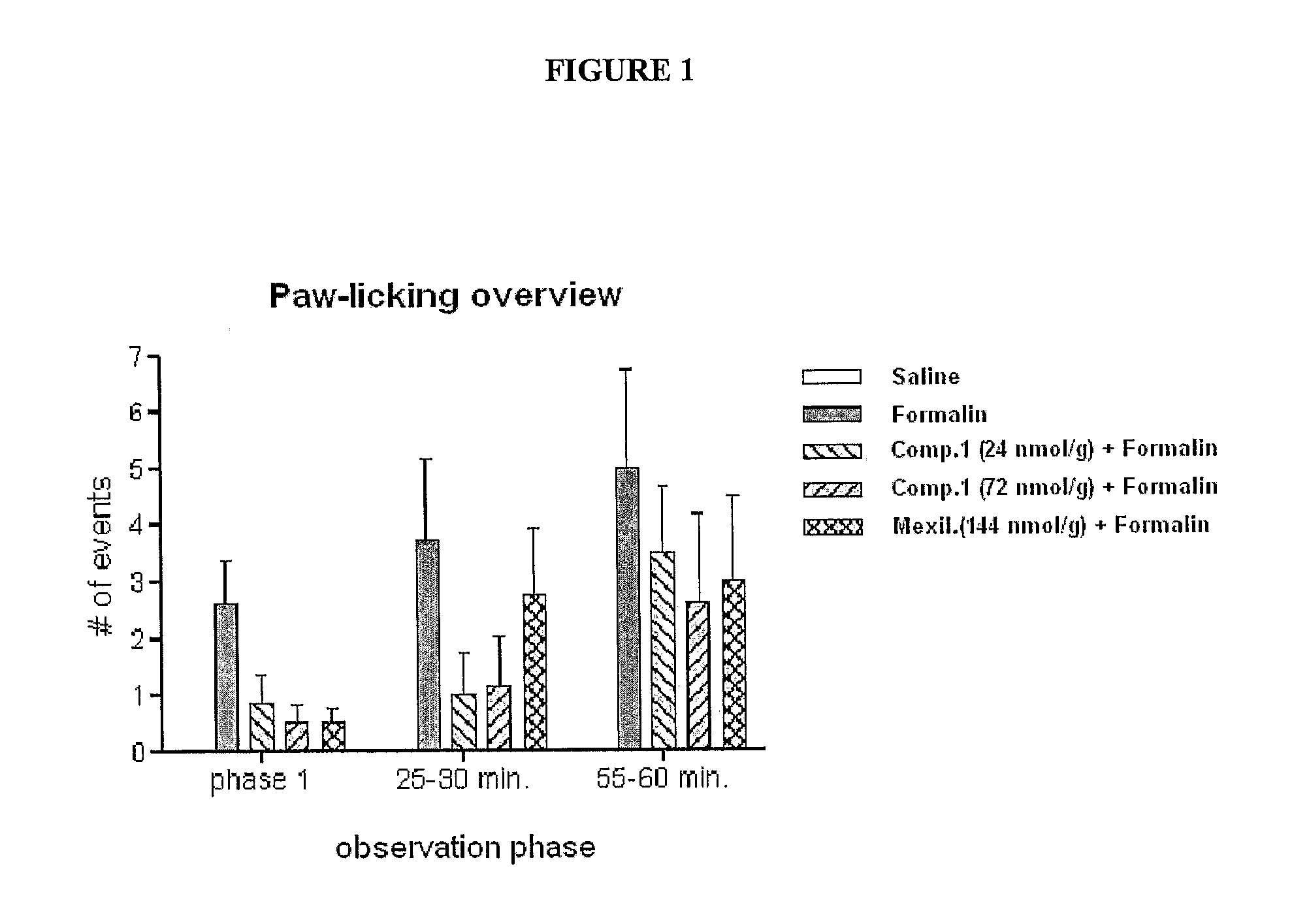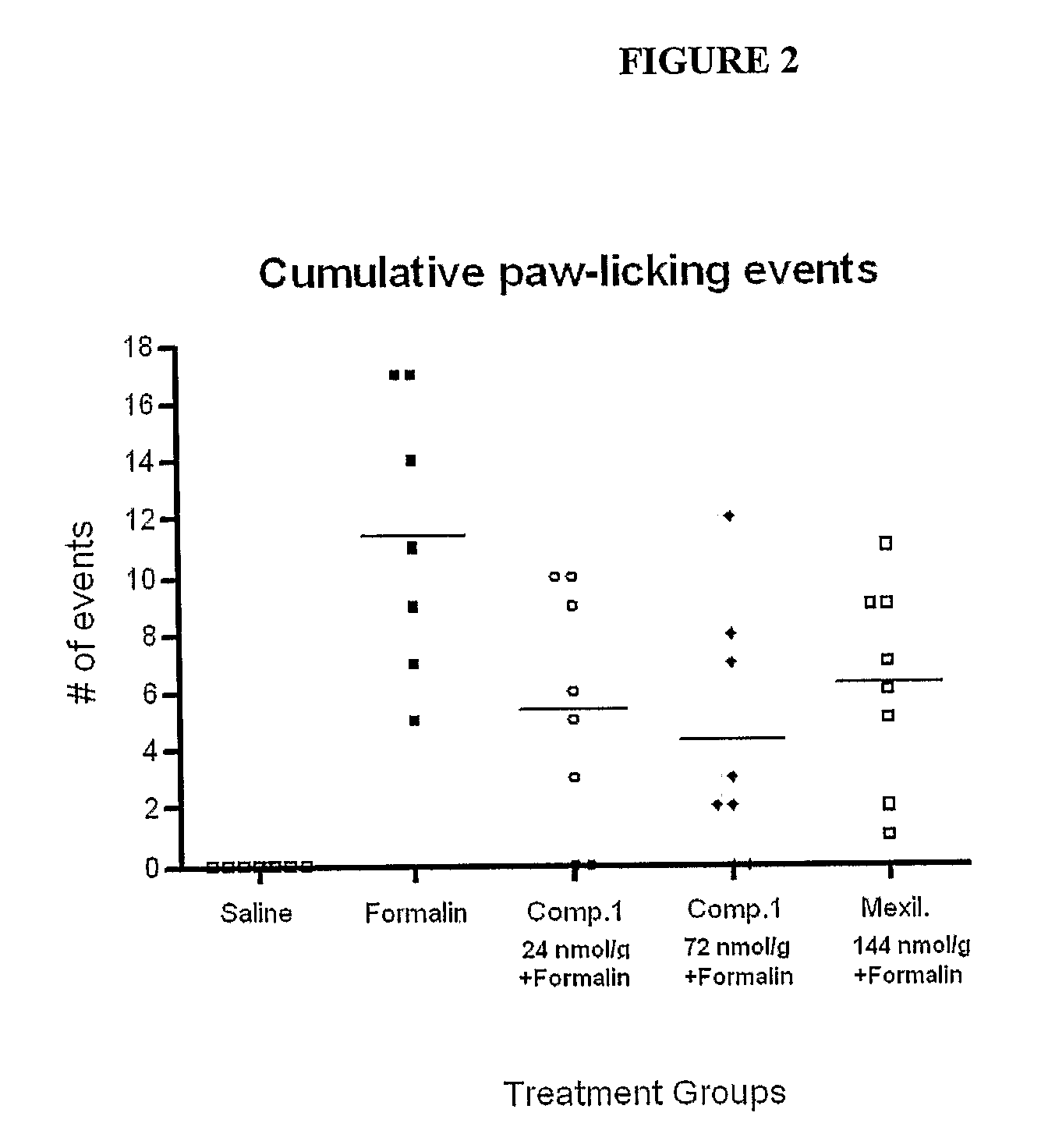Aryloxy amine compounds and their use as sodium channel modulators
- Summary
- Abstract
- Description
- Claims
- Application Information
AI Technical Summary
Benefits of technology
Problems solved by technology
Method used
Image
Examples
example 1
Preparation of Compounds 1-8
[0102]
[0103]Commercially available mexiletine hydrochloride (2.0 g, 9.24 mmol) was dissolved in dry dichloromethane (25 ml) containing 4A molecular sieves (2 g) and triethylamine (1.28 ml, 9.24 mmol) was added followed by commercially available 3,5-di-t-butyl-4-hydroxybenzaldehyde (3.37 g, 13.86 mmol). The mixture was stirred at room temperature under an atmosphere of nitrogen gas for 18 hours and then refluxed for 5 hours. The reaction mixture was cooled to room temperature and filtered to remove molecular sieves. The solvent was evaporated in a rotary evaporator and the residue was dissolved in methanol (40 ml) and tetrahydrofuran (10 ml) and sodium cyanoborohydride (1.16 g, 18.48 mmol)) was added portion wise and stirring was continued over 18 hours at room temperature under a nitrogen gas atmosphere. The reaction mixture was evaporated to dryness and 100 ml of distilled water was added. This was then extracted with dichloromethane (250 ml) and then di...
example 2
In Vitro Assay of Inhibition by Compounds to the Binding of 3H-Batrachotoxinin to the Sodium Channel Binding Site 2 in Rat Brain Membranes
[0115]This method is based on the publication by Catterall et al (1981). Rat brain membranes were prepared from Wistar rats and washed by centrifugation in fresh buffer. Aliquots of membranes were added to tubes and then incubated with 3H-batrachotoxinin (5 nM) in the absence or presence of increasing concentrations of the synthesised compounds. After incubation at 37° C. for 60 minutes, membranes were collected by rapid filtration though filters under vacuum and radioactivity in filters were determined by liquid scintillation counting. Non-specific binding of 3H-batrachotoxinin to membranes was determined by incubating membranes in a high concentration of veratridine (100 uM) and this was subtracted from all other values to determine specific binding. The concentration of each compound that inhibited specific binding of 3H-batrachotoxinin by 50% ...
example 3
Assessment of Compound 1 as an Analgesic in the Formalin Paw Test of Neuropathic Pain
[0118]The formalin paw test provides a model of nociception in which a sub-dermal injection of formalin induces a pain that occurs in time-linked phases. Rats typically respond to the injured tissue in a characteristic way that can be quantitated and statistically evaluated. The early phase is thought to be caused by C-fiber activation due to peripheral sensory stimulation, while the late phase is associated with both an inflammatory component and functional changes in the dorsal horn of the spinal cord.
[0119]The purpose of this study was to investigate the efficacy of Compound 1 to reduce the pain associated with the rat formalin paw model. In this model, the hind paw dermis of each rat was injected with a solution of formalin or saline and pain behavior was evaluated. Compound 1 and a known sodium channel blocker, Mexiletine were injected intraperitoneally 30 minutes prior to paw injection. Pain b...
PUM
 Login to View More
Login to View More Abstract
Description
Claims
Application Information
 Login to View More
Login to View More - R&D
- Intellectual Property
- Life Sciences
- Materials
- Tech Scout
- Unparalleled Data Quality
- Higher Quality Content
- 60% Fewer Hallucinations
Browse by: Latest US Patents, China's latest patents, Technical Efficacy Thesaurus, Application Domain, Technology Topic, Popular Technical Reports.
© 2025 PatSnap. All rights reserved.Legal|Privacy policy|Modern Slavery Act Transparency Statement|Sitemap|About US| Contact US: help@patsnap.com



